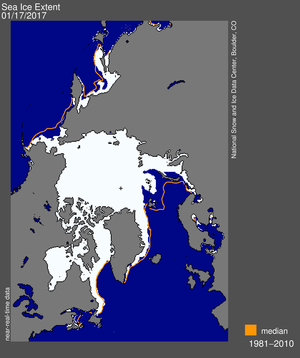As seawater freezes into sea ice, all of the dissolved constituents of the water become concentrated within the solid ice matrix that forms. Because it is more dense than seawater due to the high salt content, a lot of this ‘brine’ will drain from the ice by gravity. However, some brine remains in the ice down to −55°C, the eutectic point of seawater, at which point the ice transitions to a complete solid with no liquid fraction. Between the freezing point of seawater (about −2°C) and the eutectic, there will be brine with a salinity dependent on the temperature of the ice, up to about 8 times that salinity of seawater. But it’s not just salts that are concentrated, but also nutrients, particles, and microorganisms living within the seawater, including viruses and bacteria. A former student in the lab, Dr. Llyd Wells, discussed the consequences of this concentration effect in detail in a 2006 paper in Environmental Microbiology: “Modelled and measured dynamics of viruses in Arctic winter sea-ice brines“. In this paper he used a mathematical model to predict contact rates between bacteria and viruses as a function of temperature in sea ice brine, showing that “virus-bacteria contact rates in underlying −1°C seawater were … up to 600 times lower than those in ice brines at or below −24°C.” Two contrasting factors affected the relative contact rates. First, the brine concentrating effect described above, which increases contact rates by increasing the concentrations of viruses and bacteria in the ice. Second, the diffusivity decreases as a factor of increasing viscosity at lower temperatures, which decreases the contact rates. In the figure shown below, Llyd shows that the result of these contrasting effects is overall a positive one, with very high potential contact rates occurring in the upper, colder sea ice.

The equations used were as follows:
[tex]J = 2\pi dD_vVB[/tex]
where J = contact rate, “d is the spherical diameter of the average cell (cm), Dv the viral diffusivity (cm2 s-1), and V and B the [in situ] concentrations of viruses and bacteria respectively (ml-1 [brine or seawater]).”
[tex]D_v = \dfrac{kT}{3\pi \mu dv}[/tex]
“where k is Boltzmann’s constant, T the temperature (Kelvin), [tex]\mu[/tex] the viscosity (g cm-1 s-1), and dv the spherical diameter of the average virus (cm)”. Dv can be estimated with the following equation (determined empirically from Figure 1) where t is temperature (°C).
[tex]D_v = 40.5882 \times 10^{-9} \times 10^{0.0325t}[/tex]
The authors provide the following values for constants:
[tex]\begin{tabular}{ccc} constant & value & units\\\hline k & 1.38 \times 10^{-16}& g cm^2 K^{-1} s^{-2}\\ d & 0.5 \times 10^{-4}& cm\\ dv & 60 \times 10^{-7} & cm\\ \end{tabular}[/tex]
but they don’t provide for the calculation of [tex]\mu[/tex], the viscosity in the ice, referring to a 1975 paper by George Cox (which references a 1960 paper by Dale Kaufmann [which itself references a 1929 paper by Stakelbeck and Plank]).
The following multiple linear equation can be used to estimate the viscosity (in centipoise = 0.01 * g cm-1 s
[tex]\mu = -0.0835419T + 0.0066835S+1.7724989[/tex]
[The raw data and R script to calculate the multiple linear regression are available here]
A better empirical equation was determined using ZunZun.com, an amazingly useful site for curve fitting. I used the Function Finder, which identified a Reciprocal Polynomial as the best available curve. The simplified equation for that curve is (mu in centipoise= 0.01 * g cm-1 s-1):
[tex]\mu = \dfrac{1}{0.62 + 0.020T + 0.00014T^2 -0.0012S -0.000030ST}[/tex]
Finally, to calculate the relative contact rates between seawater and sea ice, given concentrations of bacteria and viruses (per volume brine or seawater):
[tex]\dfrac{J_i}{J_w} = \dfrac{D_{vi}}{D_{vw}} \times \dfrac{B_i}{B_w} \times \dfrac{V_i}{V_w}[/tex]
which can be generalized to:
[tex]\dfrac{J_i}{J_w} = \dfrac{D_{vi}}{D_{vw}} \times \dfrac{f_B}{V_{br}} \times \dfrac{f_V}{V_{br}}[/tex]
where Vbr is the brine volume fraction (calculator available here), “the subscripts i and w indicate sea ice and water column respectively. The terms fB and fV represent the fraction of bacteria and viruses retained in the brine and serve as a correction to account for possible partitioning within the solid phase … as well as for two major mechanisms of loss: destruction due to impinging ice crystals or osmotic stress and release with rejected brine.
If passive entrainment into the ice (proportional to salts) is expected for both viruses and bacteria, then [tex]f_B = f_V = \dfrac{S_i}{S_w}[/tex], where S is the bulk salinity of the ice or water.
If active entrainment into the ice is expected (complete/active concentration of bacteria and viruses into ice), then [tex]f_B = f_V = 1[/tex]
If the concentration of bacteria (or viruses) in the ice is 0 then fB = 0.
Another enrichment index has been used by others, including Riedel (2006), originally from Gradinger and Ikalvko (1998). Their index (Is) is 0 when the concentration in ice is 0 (Is = 0 when Ci = 0) and is 1 when the concentration in ice is proportional to the salt retained in the ice (Is = 0 when Ci/Cw =Si/Sw).
[tex]I_s = \dfrac{C_i}{C_w} \dfrac{S_w}{S_i}[/tex]
A third index can be created such that at a value of 0 indicates passive enrichment and a value of 1 indicates complete/active enrichment. A value less than zero indicates loss or mortality in the ice (-1 indicates an in situ concentration of 0). Any value greater than 1 indicates production or growth within the ice.
[tex]E = \dfrac{\dfrac{C_i}{C_w}-\dfrac{S_i}{S_w}}{1-\dfrac{S_i}{S_w}}[/tex]





1 response so far ↓
I am glad to have helped in your research. Thank you for both mentioning and complimenting my web site.
That does look like a mighty nice surface fit.
James
http://zunzun.com
zunzun@zunzun.com